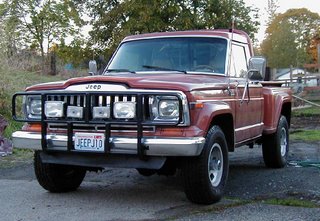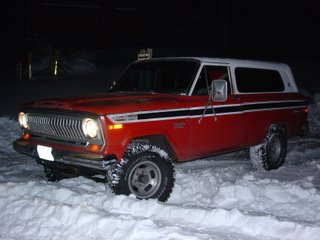


The SJ series Jeep Cherokee was a full-size SUV produced from 1974 through 1983 by the Jeep division of the American Motors Corporation. It was similar to the Wagoneer. The trim levels of the Cherokee included the S, Limited, Classic, Chief, Sport, Pioneer, and Laredo. It was designed by Brooks Stevens.
The Cherokee was a reintroduction of the two door body that had been available in the Jeep Wagoneer line (1963–67). Based on the Wagoneer, the Cherokee was marketed as the "sporty" two-door variant of Jeep's station wagon. When it was equipped with the torquey 6.6liter V8, it would out-run just about any other 4x4 in its class, and, with 3.07:1 highway gearing, could reach speeds in excess of 100mph (early s had 120mph speedometers). A four-door was not added to the lineup until 1977. Engine choices consisted of AMC I6 or V8 engines. The Cherokee was marketed in left and right hand drive countries (such as the UK and Australia). Main production of the Cherokee was in Toledo, Ohio.
Cherokees were briefly assembled in Brisbane, Australia from 1981, although their heavy fuel consumption and high cost in comparison with Japanese four-wheel drive vehicles made them uncompetitive in that market. The Australian arm of Jeep was denied permission to assemble the upcoming XJ under the Button car plan, and all Cherokee assembly was discontinued in Australia by 1986, two years after the name had been supplanted in the U.S. by the XJ.
A broad range of AMC engines were offered: the 258 in³ (4.2 L) inline six-cylinder, a two-barrel 360 in³ (5.9 L) V8, a four-barrel 360, or the 401 in³ (6.6 L) V8. The durable 401 V8 had a forged shaft and forged connecting rods, as well as the high nickel content block of the other AMC V8s. The 401 was discontinued at the end of 1978. A T-18/T-18a four speed manual gearbox was standard for all years, while, prior to 1979, one could opt for the "bulletproof" General Motors TH400, which was more commonly found in 3/4- and 1-ton trucks, rather than small SUVs. As a comparison, the Chevy Blazer used the TH350 lighter duty automatic. After 1979, the TH400 was dropped and replaced with the Chrysler 727.
A gear-driven Dana 20 transfer case with 2.03:1 low range was standard with the manual gearbox (which had much lower first gears), while the TH400 automatics received the permanent four-wheel drive QuadraTrac system. The chain-driven, aluminum QuadraTrac was quite advanced at the time. It included a center differential lock which other full time cases at the time were (and even many new ones today are) lacking. The transfer case was offset, allowing it to sit just above the frame to avoid obstacles, and the chain itself is larger than nearly any other. A test by the Four-Wheel Drive Book[1] found that the Cherokee was the only vehicle unable to be dynoed because the transfer case would not allow the rear wheels to spin, unlike the other full time four wheel drive vehicles being tested. In the off-road test, the same held true. The case was also used successfully in Baja 500 races. A 2.57:1 low range was optional on QuadraTrac.
In 1975, the Cherokee Chief package was introduced. Aside from trim, this received larger fenders and wider axles. This allowed 31" tires to be fitted from the factory to further improve off-road prowess. Four-door s could not be had with "wide-track" axles.
Dana 44 axles were used both in the front and the rear at least until 1978. Brake hardware was mostly General Motors equipment, with optional disc brakes up front and drum brakes in the rear.
The Cherokee was a reintroduction of the two door body that had been available in the Jeep Wagoneer line (1963–67). Based on the Wagoneer, the Cherokee was marketed as the "sporty" two-door variant of Jeep's station wagon. When it was equipped with the torquey 6.6liter V8, it would out-run just about any other 4x4 in its class, and, with 3.07:1 highway gearing, could reach speeds in excess of 100mph (early s had 120mph speedometers). A four-door was not added to the lineup until 1977. Engine choices consisted of AMC I6 or V8 engines. The Cherokee was marketed in left and right hand drive countries (such as the UK and Australia). Main production of the Cherokee was in Toledo, Ohio.
Cherokees were briefly assembled in Brisbane, Australia from 1981, although their heavy fuel consumption and high cost in comparison with Japanese four-wheel drive vehicles made them uncompetitive in that market. The Australian arm of Jeep was denied permission to assemble the upcoming XJ under the Button car plan, and all Cherokee assembly was discontinued in Australia by 1986, two years after the name had been supplanted in the U.S. by the XJ.
A broad range of AMC engines were offered: the 258 in³ (4.2 L) inline six-cylinder, a two-barrel 360 in³ (5.9 L) V8, a four-barrel 360, or the 401 in³ (6.6 L) V8. The durable 401 V8 had a forged shaft and forged connecting rods, as well as the high nickel content block of the other AMC V8s. The 401 was discontinued at the end of 1978. A T-18/T-18a four speed manual gearbox was standard for all years, while, prior to 1979, one could opt for the "bulletproof" General Motors TH400, which was more commonly found in 3/4- and 1-ton trucks, rather than small SUVs. As a comparison, the Chevy Blazer used the TH350 lighter duty automatic. After 1979, the TH400 was dropped and replaced with the Chrysler 727.
A gear-driven Dana 20 transfer case with 2.03:1 low range was standard with the manual gearbox (which had much lower first gears), while the TH400 automatics received the permanent four-wheel drive QuadraTrac system. The chain-driven, aluminum QuadraTrac was quite advanced at the time. It included a center differential lock which other full time cases at the time were (and even many new ones today are) lacking. The transfer case was offset, allowing it to sit just above the frame to avoid obstacles, and the chain itself is larger than nearly any other. A test by the Four-Wheel Drive Book[1] found that the Cherokee was the only vehicle unable to be dynoed because the transfer case would not allow the rear wheels to spin, unlike the other full time four wheel drive vehicles being tested. In the off-road test, the same held true. The case was also used successfully in Baja 500 races. A 2.57:1 low range was optional on QuadraTrac.
In 1975, the Cherokee Chief package was introduced. Aside from trim, this received larger fenders and wider axles. This allowed 31" tires to be fitted from the factory to further improve off-road prowess. Four-door s could not be had with "wide-track" axles.
Dana 44 axles were used both in the front and the rear at least until 1978. Brake hardware was mostly General Motors equipment, with optional disc brakes up front and drum brakes in the rear.
No comments:
Post a Comment